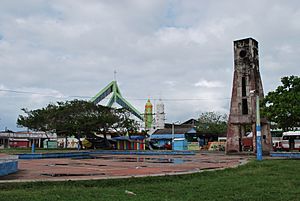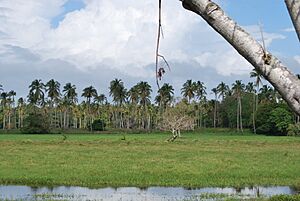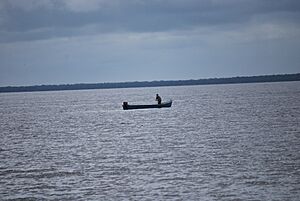Sánchez Magallanes facts for kids
Sánchez Magallanes is a small town and port in the state of Tabasco, Mexico. It's located in the northwest part of the state, in the Cárdenas area. The town is named after Coronel Andrés Sánchez Magallanes, a leader who fought during a time when France tried to control Mexico in the 1800s. This town sits on a small piece of land with the Gulf of Mexico on one side and a calm body of water called Del Carmen Lagoon on the other. Fishing is the most important job here, especially catching oysters. People also work in tourism and oil production. Sometimes, oil activities can cause pollution, which affects fishing and tourism. A big problem for the area is that the beaches are slowly disappearing due to erosion.
Contents
About Sánchez Magallanes Town
Sánchez Magallanes is located far in the northwest of the Cárdenas area. It's about 93 kilometers (58 miles) from the main city of Cárdenas. The town is about ten meters (33 feet) above sea level. It's one of the important places for social and economic growth in the region.
About 7,827 people live in Sánchez Magallanes. Many homes are independent houses.
Town History and Name
The area where Sánchez Magallanes is located has been lived in for a very long time, even since the ancient Maya people. Important explorers like Juan de Grijalva and Hernán Cortés passed through an old village here. After the Spanish arrived, the town was called Barra de Santa Ana.
There are two stories about how it got this name. One story says that in the 1800s, a kind woman from the city of Campeche gave a statue of Saint Anne to the community. Another story tells of a man who was shipwrecked and almost drowned. He prayed to Saint Anne to save him, and he survived. He then gave a statue of Saint Anne to the fishermen who rescued him.
The town's current name, Sánchez Magallanes, was given in 1909. It honors Coronel Andrés Sánchez Magallanes, who was a hero fighting against the French in the 1800s. In 1964, the community was officially recognized as a town and port.
Local Celebrations
The town's church is named after Saint Anne, who is believed to be the grandmother of Jesus. The town celebrates its patron saint from July 24th to 26th. During these days, there are religious events, sports, cultural shows, a beauty contest, and a display of local products. An Oyster Fair is also held at the same time, celebrating the town's important oyster industry.
There is a special statue of the Virgin Mary in town called “Madre Patria,” which means "Mother of the Country." It has a serpent being eaten at its feet, similar to the symbol on the Mexican national seal. The town also received a large, thirteen-meter (43-foot) sculpture of the Virgin Mary. This sculpture is made of black volcanic stone and is part of a series of seven Virgin Mary statues along a route called the “Chinandega Route.”
Geography and Environment
Sánchez Magallanes is on a small piece of land called a peninsula. The Gulf of Mexico is on its north side, and the Del Carmen Lagoon is on its south side. This strip of land is still sometimes called Barra de Santa Anna. On the west, it connects to the main land through a swampy area. The main road in town goes to the eastern tip of the peninsula. From there, a bridge crosses a gap that connects the lagoon to the Gulf.
The Del Carmen Lagoon is the calm water body that the town faces. It's one of several small lagoons separated from the Gulf of Mexico by narrow strips of land. The water here is beautiful shades of blue and green. You can rent boats for tours or to visit nearby beaches. Fishing with a rod and reel is allowed. There's also a small island called El Pajaral near the town. It's a safe place for thousands of birds and is about a twenty-minute boat ride away.
Climate and Coastal Challenges
Like the rest of Tabasco, Sánchez Magallanes has a very hot and wet climate. In winter, strong cold winds from the north can bring rain and strong winds. Wind speeds can reach up to 100 kilometers (62 miles) per hour.
For many years, experts have warned that the coast of Tabasco is delicate and easily damaged by storms. However, not much has been done to build sea walls or other protections. The Sánchez Magallanes area is especially vulnerable because the lagoons are separated from the Gulf by very thin strips of land, sometimes only a few meters wide. Damage to these lagoons can harm both fishing and farming.
Studies have shown that human activities like farming, building, and poor planning have caused serious environmental damage along the coast. Much of the natural coastal plants have disappeared. Building the coastal highway in the 1970s also caused sand dunes to vanish. This allows waves to come further inland during storms. Stronger winter storms, possibly linked to global climate change, have caused a lot of damage. Kilometers of beach have been washed away, and farmland and lagoon areas have been damaged by seawater.
Now, during storms, waves can reach the inland lagoons. This makes the ground and water saltier, which can kill plants and animals. Some animals like the manatee and a local fish called pejelagarto have become rare or disappeared. Oyster production has also decreased. Many houses are very close to the Gulf, making them vulnerable to wind and erosion. About 20 kilometers (12 miles) of the highway connecting the town to Paraiso have been destroyed or badly damaged by erosion. In 2010, the beaches were closed before a holiday because of severe erosion. Experts from the Netherlands have been brought in to study the erosion problem.
Economy and Local Life
The economy in Sánchez Magallanes relies heavily on fishing. However, there is also some farming, raising animals, tourism, and oil production.
Fishing and Oysters
Local fishing includes sea bass, shark, crab, and especially oysters. Some of the seafood is even sent to other countries. Oyster farming and collecting are very important, providing up to 75% of many families' yearly income. There are several groups of oyster farmers working in the Del Carmen-Pajonal-Machona lagoon area. These groups have received help to improve their farms and promote their oysters. This program aims to help many families who work in this industry.
However, fishing in the area faces challenges. Sometimes, harmful algae blooms called "red tide" can severely affect fishing. Pollution from oil drilling, a lack of proper equipment, and times when fishing is not allowed also cause problems. Some local fishing groups say that the amount of fish caught has dropped significantly since oil drilling started off the coast of Tabasco. They also say that pollution damages their boats and equipment.
Oil Production and Tourism
Mexico's oil company, PEMEX, started drilling for oil in the wetlands around the peninsula in the 1960s. This has led to some areas, like the Chicozapote River and the El Yucateco lagoon, being closed to fishing because of pollution. Local people sometimes say that fish from the area can taste like oil. In 2005, PEMEX cleaned up a lot of tar and other oil-related materials from the beaches, including those in Sánchez Magallanes. The beaches here are regularly checked for oil pollution, especially before holiday seasons.
Sánchez Magallanes is a place that the local government promotes for tourism. People come for its beaches, the Del Carmen Lagoon, and El Pajaral Island, which is home to many different kinds of birds. The beaches in and around the town get about 8,000 visitors during the spring, especially during the Holy Week vacation period.
One popular beach is called Acapulquito, which means "Little Acapulco." It's easy to get to the sea there, and it's free. This beach also hosts a music festival during holidays. The Ensueño del Trópico Water Park is located on the Gulf coast. It has a long beach with fine, white sand and warm, blue waters with gentle waves. The water is shallow for a long way from the shore, making it safe for swimming.
See also
In Spanish: Sánchez Magallanes para niños





